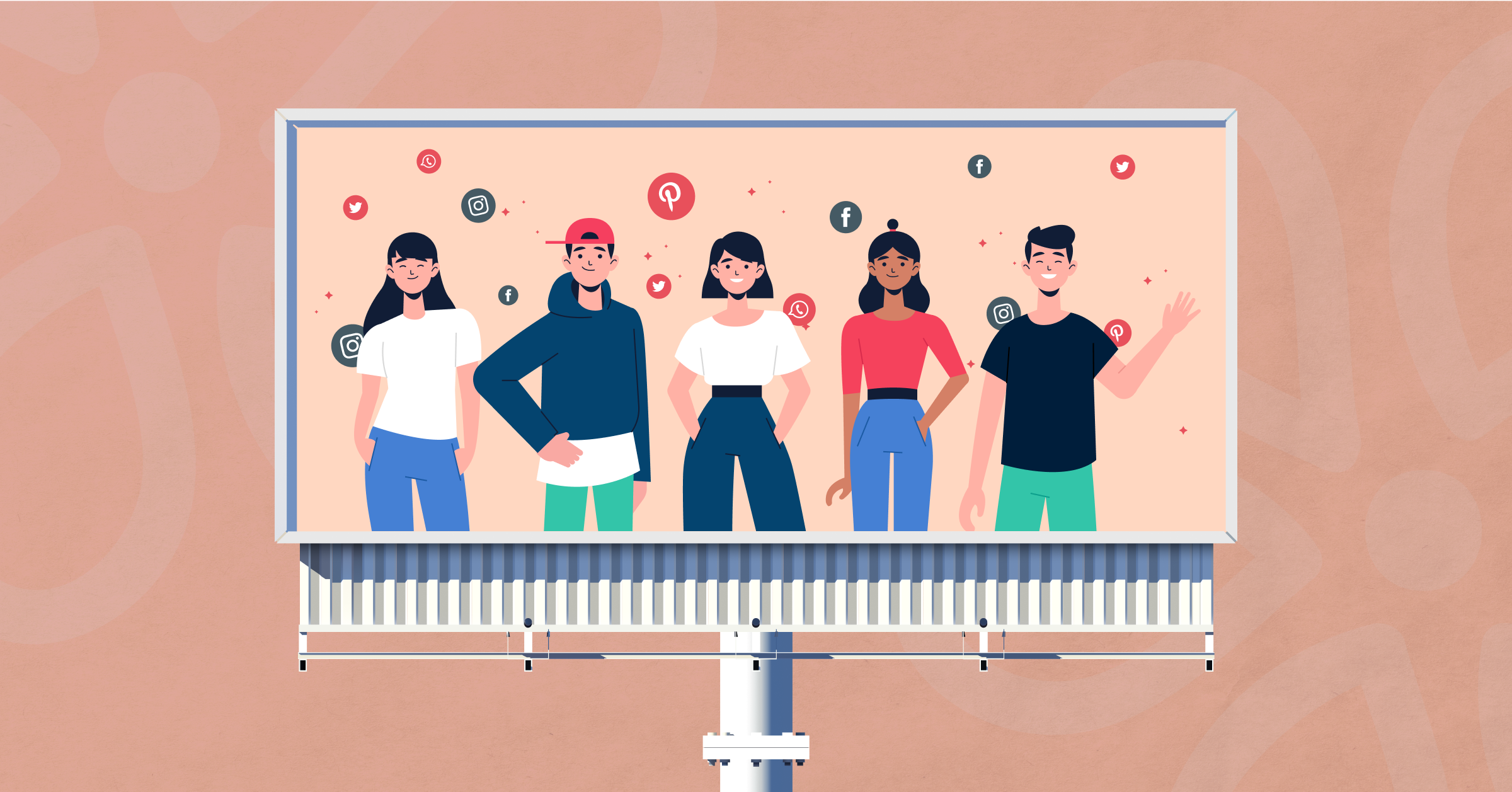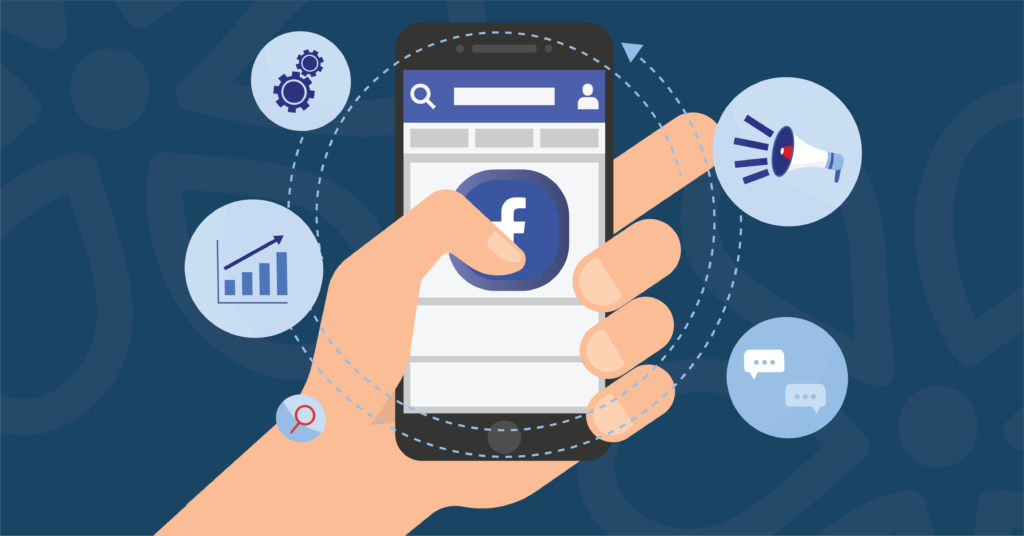Using customer touchpoints on social media and OOH ads allows you to improve your target audience’s customer experience to foster loyalty and repeat business.
Customers’ interactions and experiences with your brand significantly influence their perception and relationship with your company. That’s why it’s crucial to deeply understand your target audience and continuously assess and curate your customer touchpoints based on their feedback. Doing so can create a better customer experience that fosters loyalty and repeat business.
What are Customer Touchpoints?
The term “customer touchpoints” simply refers to any point of contact your company has with a current or potential customer. Touchpoints exist in the digital space through websites, blogs, social media, reviews, and more. They also exist in the brick-and-mortar world in the form of billboards, print ads, customer service, etc.
Touchpoints exist before and during the purchase process, and they continue even after someone has made a purchase. Therefore, it’s crucial to continuously assess customer interactions with each touchpoint to address any negative customer feedback and tweak processes to improve customer satisfaction.
Various Examples of Customer Touchpoints
Consumer touchpoints occur at every stage of the buyer’s journey, and it’s essential to take note of each so you can monitor how your target audience perceives them. Here are a few examples to be aware of:
- Social media posts
- Customer reviews
- Online advertisements
- Company events
- Word-of-mouth referrals
- Customer support and support team interactions
- Point of sale experience and sales team interactions
- Product catalogs
- Customer loyalty programs
- The checkout process in your physical store
- Pricing
- Cross-Selling or Upselling
- Email marketing campaigns
- Product pages
- Landing pages for a specific product or offer
- Post-purchase follow up
Why are Customer Touchpoints Important?
Now more than ever, consumers are overwhelmingly leaning on online research and social proof before making purchasing decisions. But unfortunately, the modern consumer is also bombarded with advertisements, experiencing anywhere from 4k-10k ads per day on average.
What does that mean for your brand?
It means you must intentionally curate a buyer’s journey through a series of well-informed touchpoints that speak directly to your audience, so you don’t get lost in the sea of ads they’ve seen that day.
Here’s how:
Put Yourself in Your Customers’ Shoes
It’s all too easy to create touchpoints based on your experience with your product or service. But how your customers interact with your brand may be very different from how an internal employee interacts with it.
Try your best to step into your customers’ shoes and ask yourself these questions:
- What pain points do I have, and what emotions am I experiencing as a result?
- Where would I go, or what would I search for to solve those pain points?
- Which solution stands out to me and why?
- Am I feeling any frustration or confusion as I work through the research and buying process?
- As I progress, do I have any questions that need to be directed to a customer service team or addressed in an FAQ section? If so, how hard is it to find an answer?
Asking yourself these questions as you move through the buying journey from a consumer’s perspective will help you understand how your touchpoints influence your brand perception. You can also ask friends, family, or focus groups to walk through the process and identify any touchpoints that gave them pause.
Understand Customer Expectations
Paying attention to customer feedback, positive and negative, can help you understand what your audience is experiencing when they interact with your touchpoints. Customer reviews, product reviews, and customer feedback surveys provide valuable information when tailoring your touchpoints to what your audience is looking for from your brand.
Insights may include identifying touchpoints that consistently cause your target audience to drop off, common questions customers have about your product or service, touchpoints that are off-brand and need revision, and more. Understanding what your audience expects from you allows your sales reps and customer service teams to refine your touchpoints further and create a seamless customer experience.
Create a Customer Journey Map
Three common stages of the customer journey include the period before a purchase, during a purchase, and after a purchase. In each stage, your potential customers will interact with a multitude of touchpoints, and one negative experience could turn them away. This is why it’s so important to intentionally position your touchpoints to move consumers through the buying journey and create a favorable reputation with your audience.
Pre-Purchase Touchpoints
In this pre-purchase stage of the consumer journey, customers have likely identified a pain point they’re experiencing, and they’re looking for solutions to solve it. New customers are learning what products and services exist, how they might help, and what price they can expect to pay for the solution.
Touchpoints in this pre-purchase typically focus on providing value, free content, and helpful information. Examples include social media marketing, blog posts, guides or checklists, and podcasts.
If you’re starting to explore customer acquisition strategies or want to revamp your current strategy, learn more here.
Purchase Touchpoints
Once your customers decide to purchase from you, it’s important to make sure your purchase touchpoints are straightforward and contribute to a favorable customer experience. Making sure that your point of sale process functions, your customer service and sales reps are helpful and easy to contact, and your product pages are descriptive and communicate value to justify your prices are all important touchpoints you don’t want to drop the ball on.
Post-Purchase Touchpoints
Now, it’s easy to assume the touchpoint map ends when a customer makes a purchase.
But customer retention is the bread and butter of any brand, increasing the lifetime value of your current customers.
This stage of the purchasing journey is where you can turn a current customer into a loyal customer who returns time after time, spreads the word about your brand, and publicly posts reviews that serve as important social proof for new customers in the pre-purchase stage.
Touchpoints in this stage include onboarding programs that reduce churn by ensuring customers know how to get the most out of their purchases. Customer loyalty programs and follow-up email campaigns also go a long way in building a solid customer base.
To illustrate the importance of researching and knowing how your touchpoints land with your audience, here’s a real-world example detailing how Gen Z and Millennials interact with advertisements. Spoiler: it’s probably not what you would expect.
Reaching Millennials and Gen Z Through Out-of-Home Advertising
When planning an advertising strategy targeted at Millennials and Gen Z, it’s easy to overlook Out Of Home (OOH) advertising.
Gen Z and Millennials are digital natives and digital almost-natives. They use their devices more than any other generation, so it stands to reason that they would like advertising native to where they spend a large amount of their time — on their screens.
Right?
Wrong.
Gen Z and Millennials Just Plain Don’t Like Digital Ads
The truth is that Gen Z and Millennials don’t want to see ads when using their device. In fact, according to a study by Kantar Millward Brown, Gen Z, and Millennials have the most animosity toward digital ads.
64% of Millennials use ad blockers to browse in peace, while Gen Z is the most likely of all contemporary generations to skip, block, or avoid advertisements than any other generation.
Heck, Gen Z hates looking at digital ads so much that 69% of them will physically do something else to avoid having to look at an ad on TikTok or Instagram. That’s right — 7 in 10 Zoomers would rather do anything else than watch an ad.
It makes sense, doesn’t it? If Gen Z and Millennials spend more time on their phones than any other generation, they’re also going to be the ones who are most annoyed by companies seeking to steal their attention and force them to look at the content they otherwise wouldn’t have.
This always-online lifestyle severely hurts digital ads’ effectiveness in reaching Gen Z and Millennials.
It’s also the reason that OOH advertising is so effective at reaching these crucial demographics.
They Hate Digital, But They Like OOH Advertising?
In a word: yes.
In the same Kantar Millward Brown study referenced earlier, Gen Z and Millennials overwhelmingly rejected digital advertisements while preferring OOH advertising like billboards or posters. Study participants in China even referred to billboards as “relaxing.”
Why?
Well, OOH advertising, unlike digital formats, gives Millennials and Gen Z a sense of control. In general, these groups don’t like the feeling of getting advertising stuffed down their throats, and the passive nature of OOH advertising gives them the power to control how they interact with the ad.
Unlike a shouting video ad that appears while you’re swiping through stories, a billboard is non-invasive, non-intruding, and non-aggressive. You can simply choose not to look at it, allowing the viewer to feel empowered and more in control.
As a result, when they do choose to engage with OOH media, Gen Z and Millennials tend to feel more positively toward the brand.
This feeling of personal choice makes OOH advertising so effective for these generations. When you’re bombarded by an endless stream of intrusive, aggressive, unskippable digital ads all day like Gen Z and Millennials are, the ability to “skip” any ad they want just by turning their head is a breath of fresh air.
Gen Z and Millennials love a sense of freedom and control over the media they consume and the information they engage with. It’s this audience empowerment that makes OOH so effective at reaching these generations. In some cases, they may feel “relaxed” as they engage with your brand in a way they control.
A Perfect Storm
There’s no better time than now to include OOH advertising in your marketing strategy.
Not only is OOH advertising the preferred method of reaching these younger demographics, but the conditions also could not be riper for a successful OOH campaign targeted at Millennials or Gen Z.
After two years of being stuck inside, people are more ready to get back out there. This lends itself to a greater possibility for OOH impressions on your audience than pre-pandemic, as people’s brains delight at the new sensory experiences outside of being stuck at your desk, skipping ads left and right.
Furthermore, the pandemic has pushed more of life online. With WFH sweeping the nation as a prevailing way to work and with schools and universities going completely remote, there’s an increasing mental fatigue amongst Gen Z and Millennials that accompanies staring at a screen for 8-12 hours a day, including the constant barrage of unskippable advertisements.
Our brains are simply not wired to take in this much digital information, leading to decreased recognition and recall of digital ads and increased agitation at digital advertisements crowding the now-digital workplace or school. OOH gives people a relaxing counterpoint to this constant digital bombardment that many of us — through no fault of our own — cannot escape.
A Caveat
While OOH advertising is one of the most effective ways to reach Gen Z and Millennials, there is a massive caveat for this channel: it cannot function on its own.
This is primarily due to physical constraints. For example, you only have so much space for a billboard, so the messaging has to be short and perfect; the visuals eye-catching and on-brand. With digital, you not only have far more time and space to get your crucial value propositions across, but you can also test and iterate as many different versions as you want to optimize performance toward conversion.
With OOH, you have limited space, so you can’t dive deep into the customer benefits that are often crucial to converting a prospect to a customer. With that in mind, OOH must be deployed in conjunction with other forms of advertising.
It’s best utilized as a wrap-around channel, supporting a more primary messaging channel like TV or digital, where you can properly educate and entice the audience on the benefits of your brand, product, or service. OOH should be used as a simple way to remind the audience of this piece of content that they’ve already been exposed to.
In other words, OOH advertising is best utilized towards existing customers or customers already familiar with the brand and this particular campaign. Again, OOH can be used as a prospecting campaign, but due to its brief and fleeting nature, it needs supporting media to flesh out the why and how of your brand, product, or service.At First Media, we distribute content where the audience is, not just with social media and other digital channels but with out-of-home media as well. Our omnichannel distribution ensures that our brands see mass audience reach and engagement. As a result, consumers are faced with high-quality content that encourages real-world action and develops consistent and cohesive relationships with brands. Using Custom Shoppable Content, proprietary AI technology for data-driven results, and digital expertise, we offer brand partners an effective opening into successful marketing for the new omnichannel customer journey. Contact us to learn more about what partnering with First Media can do for your brand.





